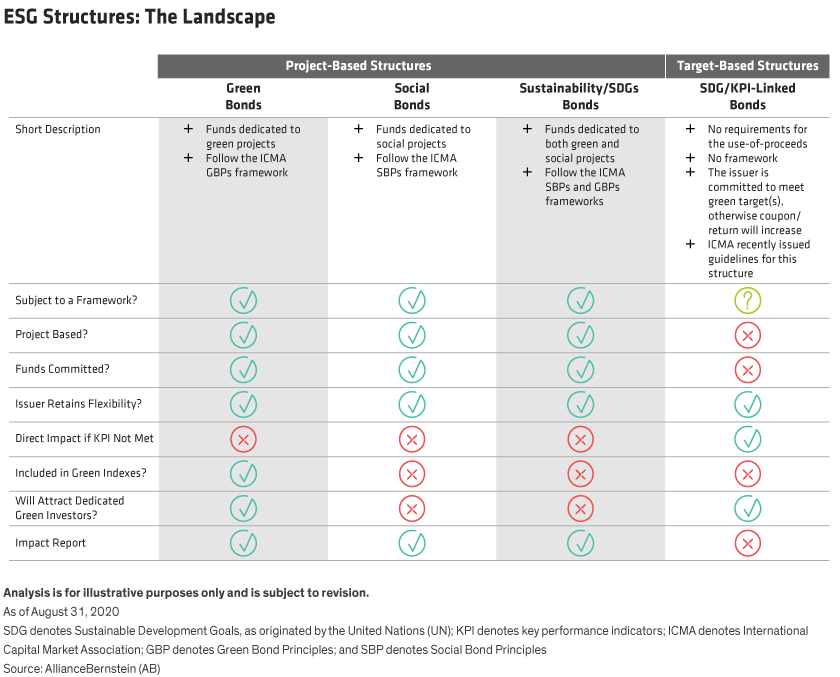Written by: Shawn Keegan and Salima Lamdouar
Investors are eager to buy green bonds. But to make the right choices, they need to analyze not only the financials, but also the governing framework of a given bond and its fit with the overall sustainability of the issuing company.
We’re optimistic about the potential for environmental, social and governance (ESG)-linked bonds to help create a better, more sustainable world. But with the recent proliferation in different types of green bond issues, investors need to understand their differences (Display).

Green bonds are use-of-proceeds structures that began as a straightforward concept—bonds that were issued for a specific project or projects with an environmentally beneficial purpose. Since then, companies have issued new types of bonds to finance a range of green, social and sustainable projects.
The most recent innovation—the KPI-linked bond—incentivizes the issuing company to achieve higher ESG standards across the business, rather than to finance a specific project. Such initiatives give issuers considerable flexibility in raising capital on ESG-linked grounds.
The proliferation of ESG-linked bonds means investors need to be aware of the technical distinctions and to understand the investment implications of each ESG-linked class.
Project-Based Structures
Green bonds are still the biggest and most popular class of ESG-linked finance, with around $575 billion in issue at the end of June 2020. We like this type of structure very much because it provides a clear link between capital investment and improving the environment, and it works well for many industries.
Still, there are several intricacies that investors should bear in mind. Proceeds for each issue are meant to finance a green project (or range of projects) in line with a specified framework and timeline. But bondholders cannot force the issuer to use the proceeds for the stated projects or to deliver them on time. Effectively, investors in green bonds are relying on the reputation of the issuing company and need to be confident about their credentials.
Also, investors should be sure that the issuer’s projects are genuinely environmentally beneficial and not misrepresented (“greenwashed”). That means verifying that the metrics established for a project’s impact report are specific, material and credible. For example, investors might determine whether a project that aims to reduce CO2 emissions will do so by a meaningful amount.
The leading index providers have established their own tests to determine whether bonds are genuinely green, but these can be subjective and aren’t necessarily exhaustive. That’s why we believe that inclusion in a green bond index does not prove that a bond is really green.
Social bonds work in the same way as green bonds but are intended to finance socially impactful projects. Examples include new buildings for communal benefit, educational programs for an underprivileged demographic or additional hospital beds for low-income areas.
Just as with green bonds, investors need to do their due diligence on the issuers and on the credibility of their projects. We have seen a resurgence in activity in this asset class in 2020, with issuers such as Italian national agency Cassa Depositi e Prestiti using this structure to help respond to the Covid-19 emergency and sustain the recovery of the Italian economy and communities.
Other use-of-proceeds, project-based structures include sustainability bonds and sustainable development goal (SDG) bonds. Use-of-proceeds for sustainability bonds include both social and environmental categories, while for SDG bonds, the pool of eligible assets can be wider and align with one or more United Nations SDGs.
Target-Based Structures
In 2020, we saw the first issue of KPI-linked bonds. In this case, the proceeds are intended for general corporate purposes, not for a specific project.
KPI-linked bonds aren’t designed to have a framework or an impact report attached to them. Instead, they are based on a measurable KPI at firm level. If the company fails to achieve the KPI within the specified timeline, the penalty is a coupon step-up on the bond. Accordingly, investors must research the company’s overall sustainability strategy and determine whether the KPI is aligned with achieving that goal.
For KPI-linked bonds, there is a direct and enforceable monetary incentive for the issuer to perform, rather than reputational risk only. This type of structure makes the issuing company accountable for executing on a top-down strategy that materially changes the sustainability of the business, as opposed to simply identifying and segregating a set of green assets while continuing with “business as usual” for its other activities.
For this reason, we very much like KPI-linked structures. We think, for instance, that greenhouse gas (GHG)-linked KPIs that are aligned with the 2 Degrees Investing Initiative are well-suited for high-emitting sectors such as energy, cement or some chemicals manufacturers.
One possible reservation about KPI-linked structures is that investors benefit from the coupon step-up if the issuer fails to hit its target. Whereas some see this as a misalignment of incentives, we view it more like the step-ups resulting from a credit downgrade—we don’t want the downgrade to happen but are due to be compensated if it does. In the future, KPI-linked structures may be developed with different issuer incentives that further improve alignment with investors’ objectives.
So far, KPI-linked bonds have been problematic for investors such as pure use-of-proceeds bond fund managers who are committed to providing specific details to their investors. But over time, we expect this problem will become manageable and that KPI-linked structures will become more popular.
Even so, KPI-linked structures need to be monitored. Investors should seek active engagement with the issuing company to get progress updates on achieving the KPI and to better understand the tools being used to meet it.
Due Diligence Still Key in Evolving ESG Bond Market
While investors now have a wide range of ESG-linked bonds to select from, they need to conduct thorough due diligence—to analyze the specifics of each structure and to understand how it supports the overall sustainability strategy of the issuing company. Identifying the right choice will also depend on the investor’s particular investments and ESG approaches.
But investors can be confident that the market is continuing to evolve to provide more choices and better accountability.
Shawn Keegan is Portfolio Manager–Credit and Salima Lamdouar is Associate Portfolio Manager–Credit at AB.
Related: Rational Exuberance? Explaining Global Equity Market Gains


